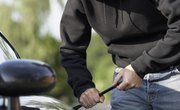
Thinking about all the bad things that can happen to your car isn't fun to do, but the reality is that they can happen to anyone -- even you. Fire is just one hazard that can damage or destroy your car and leave you without wheels -- and perhaps even owing money on a car you can’t drive anymore. Auto insurance is designed to shield you financially if something like that happens, but it’s important to understand how your policy works to get the best value from it if your car catches fire.
Minimum Coverage May Cover Basics
Most states have laws requiring at least basic coverage for public liability and property damage, or PLPD. These policies only protect you if your car injures another person or damages someone else’s property. That said, if the fire damage in question is caused by your car -- perhaps you hit a utility pole and it started a fire -- your liability coverage can protect you. However, any damage your car sustained during the incident won’t be covered by your policy.
Full-Coverage Insurance Required
Full-coverage insurance offers all the same protections as PLPD, but also protects you against financial losses from damage to your vehicle. You'll need this kind of policy if you want your car protected against losses from fire. Thus, if your car caught fire -- or started one and was damaged in the process -- your insurance would pay some or all of the damages. Full-coverage policies typically have a deductible as well. That’s the amount you’re required to pay out-of-pocket before your insurance kicks in. The additional protection you get from a full-coverage auto policy has two sections: collision and comprehensive.
Comprehensive to the Rescue
The collision section of your full-coverage policy covers just that: collisions. If you run into something -- a tree, an animal or another car, for example -- collision insurance will cover the damage, less your deductible. Comprehensive covers other losses, such as theft, vandalism or fire. Again, this variety also likely has a deductible you’ll have to pay. Other than that, though, your insurance company will cover the loss up to your policy limits and the value of your car.
Is It a Total Loss?
Having full-coverage insurance isn't a guarantee that your car will be good as new again. The amount your insurer will pay on your claim is based partially on the value of your car. Before you have any work done, you should get estimates on what the repairs will cost and turn them in to your agent. He’ll tell you whether the cost to repair the damage exceeds your car’s value. If that's the case, your car is considered a total loss, or “totaled.” You’ll still get a check, but you’ll have to decide whether to pay the outstanding amount out of pocket, or just walk away and buy another car. If you still owe money on it, you may have to cough up the extra money, or roll your negative equity into the purchase price of your next car.
References
- Esurance: Comprehensive Covers Everything -- Debunking a Car Insurance Myth
- State Farm: Types of Auto Insurance Coverage
- National Fire Protection Association. "Home Structure Fires." Accessed Sept. 24, 2020.
- Progressive. "Does insurance Cover Fire Damage?" Accessed Sept. 24, 2020.
- Insurance Information Institute. "A Vacant Home Still Needs Insurance—Don't Be Caught Without Coverage." Accessed Sept. 24, 2020.
Writer Bio
Christopher Williams has owned and operated his own small business since 2002, and has a wide range of professional experience in retail, sales and insurance industries. He's been writing professionally since 2004.

